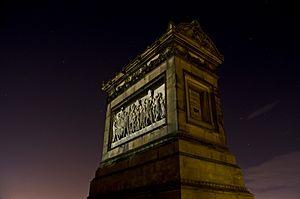Craigentinny Marbles facts for kids
 |
|
| Coordinates | 55°57′26″N 3°08′14″W / 55.95710°N 3.13716°W |
|---|---|
| Location | Edinburgh, Scotland |
| Beginning date | 1848 |
| Completion date | 1856 |
The Craigentinny Marbles is a very special monument located in Edinburgh, Scotland. It is a mausoleum, which is a grand building or tomb built to honor and hold the body of an important person. This particular mausoleum was built for William Henry Miller. He was a wealthy landowner and also a Member of Parliament, meaning he was involved in making laws for the country.
Contents
What are the Craigentinny Marbles?
The Craigentinny Marbles is the final resting place for William Henry Miller (1789-1848). He was a rich man who owned a lot of land. He also served as a Member of Parliament for a place called Newcastle-under-Lyme. After he lost his parliamentary seat in 1841, he moved to his estate at Craigentinny.
When Miller passed away in 1848, he didn't have any children. So, a distant relative named Samuel Christy was in charge of carrying out his wishes. Miller's will asked for his body to be buried in a deep pit, about 20 feet deep. Above this pit, a monument would be built. This monument was meant to celebrate his personal good qualities.
Building the Monument
A lot of money was set aside for building this monument, about £20,000. When it was first planned, the monument would have stood alone on a wide, open area of land. This area was about half a mile east of Miller's home, Craigentinny House. Today, however, the monument is surrounded by houses built in the 1930s. These homes are on Craigentinny Crescent, making the monument look a bit out of place.
The mausoleum itself was designed by an architect named David Rhind. It was finished in 1856. Later, two beautiful sculptures were added. These were created by Alfred Gatley. These sculptures are called bas-reliefs, which means they are carved into a flat surface but stick out from it.
The Amazing Sculptures
The two sculptures tell parts of a famous Bible story called the Exodus. This story is about the Israelites escaping from Egypt.
The Red Sea Scene
On the north side of the monument, there is a sculpture called 'The Overthrow of Pharaoh in the Red Sea'. This artwork shows a dramatic moment. It depicts the army of Ramesses II, the Egyptian Pharaoh, being destroyed. This happened during the crossing of the Red Sea by the Israelites. This particular sculpture was finished in time to be shown at a big event called the 1862 International Exhibition in London.
The Song of Celebration
On the south side, you'll find the other sculpture, 'The Song of Moses and Miriam'. This one shows the Israelites singing a joyful song. They are celebrating their escape from Egypt and the defeat of the Egyptian army. This sculpture was completed just before Alfred Gatley passed away in 1863. He died from an illness called dysentery.
A Special Building
In 1970, the Craigentinny Marbles monument was given a special status. It was named a Category A listed building. This means it is considered a building of great historical or architectural importance. It is protected to make sure it lasts for many more years.


